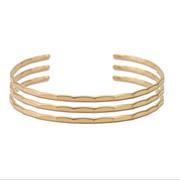Earlier this week I had a customer who was IN LOVE with her new hammered cuffs, but she wanted to see them joined together. Soldering is the first solution that usually jumps to mind, but soldering gold fill is exceedingly tricky and occasionally impossible, as the underlying layers of brass can be pulled to the surface with too much heat, obscuring the 14K outer layer. This will reduce the piece's shine and create an unsightly tarnish over time. A simple solution is to join the ends of the cuffs by putting a tiny pin, called a rivet, through them.

For these cuffs, since we wanted a little spread across their tops, I hammered the ends at the slightest of angles, and then drilled a hole exactly the size of the rivet in the exact same place across the set of cuffs. After fitting the rivet through, which at this point is just a straight piece of wire, it has to be carefully hammered to dome it out on both sides and bring it flush against the cuffs at its edges. It's such a tidy and satisfying result, after the precision and exactness that is required to get there.

Riveting isn't restricted to gold filled cuffs, either. We can use rivets to join a single bangle together and rivets can be used to close and decorate rings, too. I particularly like rivets when they're made in contrasting metals, which makes them as much an element of design as it makes them functional. Of course, silver cuffs can easily be soldered, but only when the entire set is made from sterling cuffs.

Want to follow along with more of my custom work? Follow me on IG:









